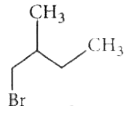Consider reactions (E)- (G) :

(a) Which reaction is the fastest ? Briefly explain.
(b)
What is the major product of the fastest reaction ? Briefly explain.
(c) Write a detailed curved arrow mechanism that shows how the major product is formed. Write "rds" above the arrow in the rate determining step of the mechanism.
(d) Provide an explanation for the choice of the rate determining step.
Text Solution
(a) The relative rates of these reactions are controlled by their rate determing step (carbocation formation). The most stable carbocation is formed more quickly because its formation has a low Eact.


All the carbocations are secondary , but only the carbocation formed in reaction (F) has the extra stability afforded by resonance . Therefore , the fastest reaction is (F).
(b) 
This product results when the carbocation intermediate captures chloride ion, the formation of which is shown in answer (c) :
(c) 
(d) When a reaction proceeds via a mechanism that has more than one step, the overall reaction rate is dominated by the rate determining (i.e., the slowest) step . In this reaction the slowest step is the first step in which the energetically expensive process of carbocation formation occurs. The more stable the carbocation that is formed , the faster is the rate of this step . Of all the carbocations that would have to be formed to produce the products shown above, the most stable one (shown below) is secondary with resoanace)

Since this carbocation is the most stable, it will be formed most readily , and thus in a large amount. As this is the most prevalent carbocation, it forms most of the product.
|
Topper's Solved these Questions
- ALKENES AND ALKYNES IIBOOK - MS CHOUHANCHAPTER - ALKENES AND ALKYNES IIEXERCISE - ADDITIONAL OBJECTIVE QUESTIONS (Single Correct Choice Type)
25 Videos
- ALKENES AND ALKYNES IIBOOK - MS CHOUHANCHAPTER - ALKENES AND ALKYNES IIEXERCISE - ADDITIONAL OBJECTIVE QUESTIONS (Matrix Match Type)
2 Videos
- ALDOL AND CANNIZARO REACTIONBOOK - MS CHOUHANCHAPTER - ALDOL AND CANNIZARO REACTIONEXERCISE - Subjective Problems
3 Videos
- ALKENES AND ALKYNES IBOOK - MS CHOUHANCHAPTER - ALKENES AND ALKYNES IEXERCISE - Additional Objective Questions (Multiple Correct Choice Type)
2 Videos
Similar Questions
Knowledge Check

The major product of the above reaction isA B
B C
C D
D

The major product of the above reaction isA B
B C
C D
D

major product of the above reaction is :A B
B C
C D
D







